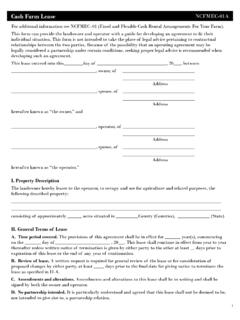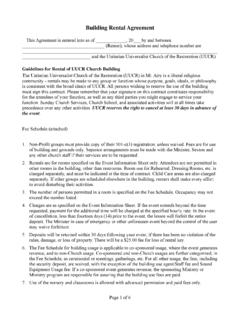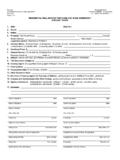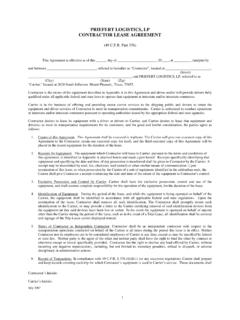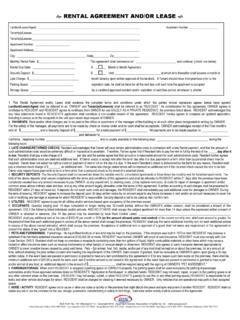Transcription of NCFMEC-04 NORTH CENTRAL FARM MANAGEMENT …
1 NORTH CENTRALFARM MANAGEMENTEXTENSION COMMITTEENCFMEC-04 rental Agreements For farm Buildings and Livestock FacilitiesAcknowledgementsThis publication is a product of the NORTH CENTRAL Regional (NCR) Cooperative extension Services of:IllinoisIndianaIowaKansasMichiganMinn esotaMissouriNebraskaNorth DakotaOhioOklahomaSouth DakotaWisconsinandThe USDA National Institute of Food and Agriculture (NIFA)FundingFunding for this project was provided by the NORTH CENTRAL Risk MANAGEMENT Education Center ( ) and the USDA National Institute of Food and Agriculture ( )This material is based upon work supported by USDA/NIFA under Award Number 2010-49200-06200 NCFMEC-04 February 2013 2013 by the NORTH CENTRAL farm MANAGEMENT extension CommitteeFor more information about this and other leases, visit buildings and livestock facilities often outlast their owner s need for them, but are still usable.
2 Other operators want the services of certain types of farm buildings but are not in a position to invest in new facilities. Both parties can benefit by developing a lease arrangement. The owner receives a return from resources that might otherwise lie idle or be underutilized. The operator can use these resources without making a large fixed investment. However, they must agree on the amount of the rental payment and the use and care of the publication examines the major considerations in developing rental agreements for crop and livestock buildings and facilities from both the owner s and operator s points of view.
3 Three different approaches to determining a cash rental rate will be presented. Finally, several other important considerations for developing a lease agreement will be discussed. A sample lease form is also Agreements For farm Buildings and Livestock FacilitiesTable of ContentsValue of the Facilities to the Operator 1 Establishing a rental Rate 1 Owner s Cost 2 Commercial Rates 4 farm Records 4 Special Considerations 4 Repairs 4 Water 5 Manure Disposal 5 Insurance
4 6 Time and Basis of Payment 6 Common Provision in a Lease 6 Worksheet 8 farm Building or Livestock Facility Lease i1 farm buildings and livestock facilities often outlast their owner s need for them, but are still usable. Other operators may want the use of certain types of farm buildings but are not in a position to invest in new facilities. Both parties can benefit by developing a leasing arrangement. The owner receives a return from resources which might otherwise lie idle or be underutilized.
5 The operator can use these resources without making a large fixed investment. However, they must agree on the amount of the rental payment and the use and care of the publication examines the major considerations in developing rental agreements for crop and livestock buildings and facilities from both the owner s and operator s points of view. Three different approaches to determining a cash rental rate will be presented. Finally, several other important considerations for developing a lease agreement will be of the Facilities to the OperatorThe operator should carefully budget the added net income that could reasonably be expected from using the building or facility.
6 This provides an estimate of how much the operator can afford to pay for the use of the operator should consider several key factors before entering into a rental agreement:Condition Are the building and equipment in usable condition? Will major repairs be needed? Who will pay for repairs and maintenance? Will operating costs be unusually high? Poor feed storage may result in high spoilage, or livestock performance may suffer if equipment breaks Does the facility reflect current technology? Can replacement parts be easily obtained? Does it meet current environmental regulations?
7 Extra labor, MANAGEMENT and supervision may be required with outdated Does the building or equipment fit the operator s current needs? A hog producer may have little use for a silo or milking Are the buildings and equipment of large enough capacity for profitable livestock production, considering the operator s labor and feed supplies? Is the storage facility large enough for the quantity of grain, forage or machinery to be stored? Or is it too large to be used efficiently or to match the operator s other equipment?Location How far are facilities located from the operator s base of operations?
8 Distant buildings are less valuable to the operator because of the higher transportation costs and greater inconvenience involved. Security risks are higher if livestock, machinery or stored crops are located where they cannot be regularly Is the operation of equipment simple and efficient? Can grain or livestock be easily unloaded and loaded? Does the building contain features which increase operator safety or comfort? Or, is it of a design that poses physical risk to the operator and livestock?Alternatives Could the same services or facilities be obtained elsewhere? At what cost?
9 If the owner is offering a service that is difficult to obtain in the area, a higher rental rate will likely result. Likewise, the number of other people who might want to rent the same building will impact its rental a rental RateMost owners and operators want to determine a fair and reasonable rental rate given the particular circumstances of their situation. However, a common or typical rental rate for a particular building or piece of equipment seldom exists. In many areas there is no widespread market for specialized livestock buildings. The fixed location of existing structures often narrows the market to just a few prospective operators.
10 The factors surrounding each individual case and the bargaining position of each of the parties involved will determine the final rental s CostsOwners are primarily interested in recovering their costs for a particular farm building or facility, particularly any operating costs not paid directly by the operator. In addition, owners may consider proper care and maintenance of their property to be important. At a minimum the rental rate should cover any added costs related to the use of the facility. These variable costs include use-related repair and maintenance costs, utilities expense and additional wear and of the owner s costs will remain the same regardless of how much the asset is used.




